|
 Cyttaria gunnii Cyttaria gunnii
Images (click to enlarge)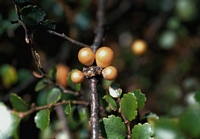
Owner: Hiroaki Setoguchi | 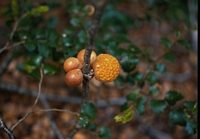
Owner: Hiroaki Setoguchi | 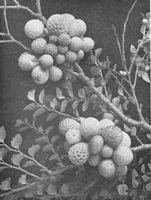
Caption: Plate 9. Cyttaria gunnii on Nothofagus menziesii. (Photo by the late W. C. Davies, of the Cawthron
Institute.) | 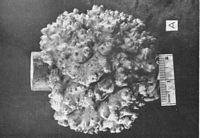
Caption: Plate 11 C. Decorticated Cyttaria gunnii galls on Nothofagus menziesii.. | 
Caption: Plate 12C. Galls of Cyttaria gunnii on Nothofagus menziesii sapling. One gall decorticated. (Photo
N.Z.F.S.) | 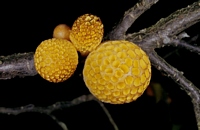
Caption: on planted N. menziesii
Owner: Peter Johnston | 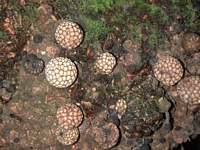
Owner: J.A. Cooper | 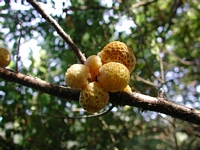
Caption: fruitbodies in tree
Owner: J.A. Cooper | 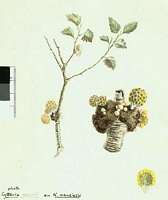
Caption: Watercolour
Owner: G.M. Taylor |
Article: Rawlings, G.B. (1956). Australasian Cyttariaceae. Transactions of the Royal Society of New Zealand 84: 19-28.
Description: Stromata solitary or in dense clusters, up to 2 cm in diameter, pear-shaped, smooth and dry
but becoming slimy if wetted, fawn or tan above, light coloured below, bright yellow when
mature except for a sterile base which remains white. Hollow at maturity, internal fibres
white. Apothecia very numerous, up to 200, bright yellow.
Papillae small, scattered between apothecia, appearing as white flecks on young stroma,
arising as minute elevations within shallow depressions, not raised above the surface of the
stroma. Pycnidia absent. Asci 145-165 x 14 µm, ascospores sub-globose 12-12.5 x 6.5-12 µ,
dark coloured, spore print black. Paraphyses as long as asci, 2 µ wide, septate, branched,
swollen at ends.
Habitat: An obligate parasite forming globose galls on Nothofagus menziesii (Hook f.) Oerst., in
New Zealand and Nothofagus cunninghamii (Hook. f.) Oerst., in Tasmania and Victoria.
Range in New Zealand as for host.
Notes: The sporophores of this species first appear at the time when the buds of the host are
beginning to swell; in Southland, in 1946, when most of the investigation was carried out, this
occurred during the first week of September. Spore shedding starts early in October and
reaches a peak towards the end of November. The first fructifications seen were growing
from small twigs showing, little or no sign of gall formation; large galls produce fructifications
later.
The galls are small in proportion to the diameter of the branch or stem, as compared with
those of C. nigra; they usually occupy about two-thirds of the circumference of the branch
and are flattened slightly at the point of origin. When a branch is completely girdled the upper
part may die, in which case the death of the gall may follow. In contrast to C. nigra, galls on
the main stem take the. form of rope-like encircling bands.. for example one sapling of 11 in
d.b.h. had three galls, at 3ft, 4ft 2in. and 5ft 6in from the ground. The lowest was 2 in high
and 12 in in circumference, leaving 1 in of bark unaffected, the middle gall was 12 in high and
10 in in circumference, and the highest was 1 1/2 in high and 11 in in circumference. The last
two galls cornpletely encircled the stem. See Plate 12 C.
The surface of the gall appears smooth, but if the bark is removed the wood is found to be
very uneven, being contorted and produced into sharp spines, the tips of which split into fibres
which penetrate through the bark. It is from these points that the stromata develop. The scar
left on the gall when the fructification falls is a white circular spot, with, in many cases, the
remains of the central tube of fibres which pulls out of the stroma.
Article: Dingley, J.M. (1969). Records of plant diseases in New Zealand. New Zealand Department of Scientific and Industrial Research, Bulletin 192: 298 p. Wellington:.
Notes: Berkeley (1848) described this species from living branches of Nothofagus cunninghamii
from Tasmania. In New Zealand this indigenous gall-forming fungus attacks only one
species of Nothofagus (N. menziesii) (Lloyd 1916; Cockayne, 1926). The galls are
perennial, producing a crop of fructifications each spring throughout the life of the tree.
The fungus causes distortion of branches but produces no decay of host tissues. Rawlings
(1956) stated that it is of little economic importance but suggested that infected trunks
should be removed when sapling stands of silver beech are "managed".
Article: Gadgil, P.D. (in association with Dick, M.A.; Hood, I.A.; Pennycook, S.R.) (2005). Fungi on trees and shrubs in New Zealand. Fungi of New Zealand. Ngā Harore o Aotearoa 4: xi + 437 p. Hong Kong: Fungal Diversity Press.
Description: Type: Caulicolous Fungi; Description: Ascomata a hollow sphere, with the outer surface composed of a honeycomb of small, angular, cup-shaped ascigerous cavities, fawn to bright yellow, up to 2 cm in diameter; borne on woody, perennial galls; branch galls roughly spherical, rarely more than twice the diameter of the host branch, usually occupying about two-thirds of its circumference; stem galls usually in the form of encircling bands; gall surface under the bark contorted and projected into sharp spines. Asci cylindrical, 155 × 14 m. Ascospores subglobose, 12 × 9 m, dark coloured, black in mass.
Distribution: Distribution: Taupo, Gisborne, Nelson, Buller, Westland, Fiordland, North Canterbury, Otago Lakes, Dunedin, Southland.; 1st Record: Lloyd (1916).
|